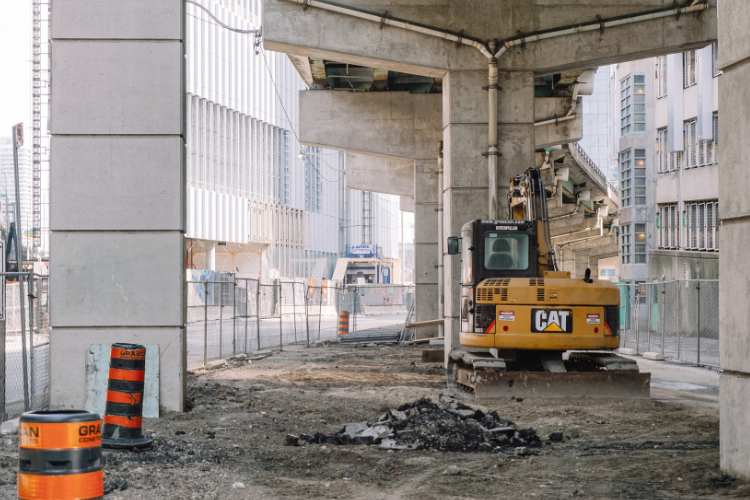Plenty of subs sign their contracts without ever seeing the GC’s prime contract. It’s not common practice among subs to ask for it, but here’s the thing: it needs to be. Maegan Spivey, a Contracts Manager in the construction industry, is on a mission to get subcontractors in the habit of requesting it any time terms in the prime contract are included in their subcontracts (and they usually are!). We sat down with Spivey to get her take on prime contract reviews and how to approach them.
Table of Contents
You Are Just As Bound to The Prime Contract As the GC
This is the core argument for why you need to see the prime contract. If your contract with the GC incorporates terms from the prime contract, you are bound to the same terms as the GC. By not reviewing the prime contract, you’re missing part of your own, and don’t know what you’re signing up for. You would never intentionally go in blind like that for your own subcontracts. According to Spivey, this is not common practice already, which is concerning because of the dangerous implications for subs.
It’s not just about redlining and looking for unfavorable terms in the prime contract. It’s about checking to see if the good aspects of their contracts are reflected in yours as well. For that reason, requesting the prime contract effectively becomes a competitive advantage. If most subs aren’t asking for it and you are, you understand your contract better than most subs. Bottom line: it’s not just about your liability in a crisis. It’s also about confirming your logistical ability to do this job. It’s about safeguarding the benefits that you could be receiving along with the GC.
Why Subcontractors Don’t Request the Prime Contract
If you’re thinking, “Oh no, I’ve been missing out,” you’re not alone. Here are some reasons subs are discouraged from going through the review process.
-
- Time Constraints – Subs are compelled to keep things moving. The sooner they sign the contract, the sooner they start the job, the sooner they get paid. Review takes time. Requesting changes takes time. Getting changes finalized takes time. But the time spent reviewing contracts pays dividends down the line. You could avoid being in the chokehold of unfavorable terms (Endless, unpaid change orders, anyone? Or paying to fix problems you didn’t cause?), avoid costly litigation, and even get paid sooner.
- Assuming They Won’t Get It – Subs are sometimes hesitant to ask for the prime contract because they think their GC will refuse. Spivey has yet to see this be the case. Don’t preemptively assume you can’t see the contract, because if you’re bound by terms in the prime contract, you’re entitled to it.
- Nothing Bad Has Happened from Not Doing It – If subs have gone hundreds of projects without doing it and nothing bad has happened, it’s not going to feel like a top priority to tackle. Unfortunately, “if it ain’t broke, don’t fix it,” isn’t the most progressive mindset. Again, it’s not just about catching negative terms that would cost you money in a crisis, it’s about applying the positive terms too. You shortchange yourself if you neglect it.
- Not Investing in a Contracts Manager – Subs know that it’s just not realistic to send every agreement to your attorney. Attorneys are pricey. However, contracts managers are a cost effective alternative to attorney reviews once you know how you want to mitigate risks for your business, because you can hire them part time or use them on an as-needed basis.
Not Convinced? Here Are Some Examples of How Prime Contract Review Can Benefit You
Example #1 – Ensuring Favorable Retainage Terms Flow Downstream: Spivey has seen one prime contract that excluded materials and storage from retainage. If the subcontract didn’t include this benefit, then the sub would have had additional revenue tied up in retainage.
Example #2 – Broad Liquidated Damages: Spivey worked with a subconsultant who had limited negotiation power on the job. He wasn’t building anything; he was just doing testing on site. Without his certificate of testing, the GC couldn’t get a certificate of occupancy, which put the GC at risk for liquidated damages. However, because the subconsultant was on site, they still needed to be under contract. With flow down clauses in the prime contract, this subconsultant was liable for liquidated damages. Their first instinct was to strike liquidated damages in the contract. However, the issue wasn’t really liquidated damages. The subconsultant simply didn’t want to be held liable for delays or problems that other subs might cause. So they adjusted the language of the clause to specify that they wouldn’t be held liable for those kinds of problems or delays. When they sent the LD redlines to the GC, the GC readily accepted the changes. Some might say that liquidated damages are a flow down clause you can’t change, but with some thoughtful redlines, you can still find creative ways to mitigate your risk.
Example #3 – Locating Requirements That You Can’t Meet, Before You Take the Job: Certain compliance requirements, for example, may only be listed in the prime contract. Spivey knows of subs who lost a lot of money on projects by not reading the entirety of their contracts, because they were bound to requirements the sub simply couldn’t meet. In another example, when Spivey was working for a GC, they passed on a project after reviewing the contract because the company didn’t have the administrative bandwidth to profitably do the job with all of its reporting requirements. Because it was public works, that was a requirement they couldn’t redline out.
The Prime Contract Evaluation Process:
1. Get the Right Members of Your Team Involved
It may not be practical to get all the people listed below together for every contract – but it would be helpful while your company is coming up with a contracting strategy. From there, it’s easier to simply have a point person (like a contracts manager) who has everyone’s inputs and can execute accordingly, and then a decision maker they can tap when necessary.
- If available, the owner, COO or other key decision maker who has the power to bind the company to an agreement, should be present.
- The person in your organization dedicated to contracts, like a contracts manager or other person whose workflow includes contract review.
- Optional: Other stakeholders can offer valuable input around things you may not think of, like liability, indemnification, or jobsite logistics. These stakeholders include project admin, project managers, insurance agents and lawyers. Construction lawyers will often have unique insight based on cases they’ve litigated or seen. Always remember that contracts touch every area of a business, so gathering input from everyone it will affect can help you make it work for everyone it will affect.
Collaborate on a Contract the Same Way You’d Collaborate in the Field
On a jobsite, subcontractors are creative problem solvers. But, have those same people review a contract, and they need a push to use that creativity. Spivey wants subs to take their creativity from the field and bring it to the contract negotiation table. It’s also a space for collaboration between owner, contracts manager, lawyer or anyone else invited to review, if that much collaboration is necessary. While all that brain power can be helpful, Spivey reminds subs that it’s not always efficient or necessary. If you’re dealing with unusual contract terms or highly prioritized redlines that got rejected, then you may want to pull in the owner/decision maker, or your construction attorney.
Spivey explains how she and her husband (an experienced PM) will review the contract in tandem, with different roles. She’ll unpack the terms the contract is laying down; her husband will lay down the conditions he thinks the contract should contain and ensure the scope is tight, and Spivey will get to work on perfecting the contractual wording that will reflect those conditions for the project.
2. Start Carefully Reviewing the Contract
As you review the prime agreement, keep an eye out for the following:
- Flowdown Clauses – This is a catchall term for clauses that apply not only to the GC, but to you as well. They won’t always be earmarked with the words “FLOW DOWN.” So you’re going to have to read the whole contract (both prime and your contract) and do it carefully. And you won’t always find flowdowns in the same places every time. Generally speaking, everything flows down equally to all subs, regardless of their trade. Certain risks may be lower for certain subs, with rare exemptions based on trade. But you won’t know unless you carefully read what terms are getting passed down to you.
- Mutual Things – Check for things that the GC has negotiated with the owner that are mutual, like mutual termination for convenience, mutually having consequential damages waived or mutual indemnification (and those terms).
- Contractual Completion Dates – If the GC is held to a specific completion date, you will be held to that date as well.
- Contractual Milestones – Look for milestones that apply to the GC that extend to you.
Rank Your Redlines by Priority
During the contract review process, it pays to have well-defined priorities. As you compile aspects of the subcontract you want to question or change, sort them into a tiered priority list, with “Must Haves,” “Nice to Haves,” and things you can simply let go of. Spivey understands that some subs may have doubts about zealously redlining. After all, do you really want to be THAT sub who’s giving back 10 pages of redlines? The best way to go is to consciously prioritize your big ticket items. Then, as your negotiating power increases, include lower priority issues. This helps you take a more strategic approach to redlining.
Using MSAs to Streamline Prime Contract Review
If you work with a GC regularly, getting the terms and conditions onto an MSA will help you take care of the terms and conditions up front and focus on project specifics going forward. Ideally, you don’t have to do the redlining process a lot if you get under an MSA. It’s all about coming up with a strategy that’s right for your business. Contract reading isn’t a money making activity, it’s a risk mitigation tool. In that sense, you don’t need perfection, you need utility. And if you find a repeatable process for how to protect your company from project to project, then use it. You need what’s right for your business.
3. Send Your Redlines to the GC
Initially, you’ll want to redline on your own, email your redlines to the GC and see what their response is. However, if you can’t come to an agreement over two emails, arrange to review it together with the GC. This is inherently more collaborative, less adversarial and may even be quicker. Many people in the industry are more likely to jump on a phone call or hop in a meeting to get things hashed out quickly. When it comes to calling or emailing first, it’s a matter of preference and depends on the relationship between the GC and sub. Some subs have better luck calling first, others have no problems from emailing first. If the GC doesn’t fully accept your redlines, but their response is reasonable and they want to reach a fair compromise, it’s worth signing and moving on if it accomplishes the goal of your original redlines.
Best Practices with Contracts Managers
- Contracts managers are an extension of you, so make sure they know exactly what you would want in the contract. The more they know, the better they can execute your vision.
- Keep in mind the differences between your attorney and contracts manager. Your attorney helps you understand and define your business risks, while a contracts manager is executing that vision for your business, one contract at a time.
- Smaller subs can start with a contracts manager part time, or on an as needed basis. As they grow, an in-house contracts manager may make more sense. If you don’t hire someone specifically for this role, you can pinpoint someone within your organization who can grow into this role, or is already showing an interest in contracts.
Never forget that some contract changes may make a huge difference to you, but may not be a big deal to the other party. It’s essential for you to have all the information on what you’re being asked to agree to when you manage risk for your company – that principle is at the center of prime contract review. So, grab your red pens, and get to work.
Spivey recommends a book called Contract Redlining Etiquette by Nada Alnajafi.







